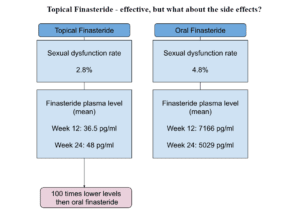Is Finasteride Effective for Hair Growth?
In a prior blog, I wrote about the efficacy of topical finasteride. More hair restoration patients (especially male pattern hair loss patients) are interested in topical finasteride because they heard that the risk or rate of side effects is lower compared to oral finasteride. In terms of the efficacy of topical finasteride, Piraccini et al did a very well-done research study showing that topical finasteride significantly increased hair density on the scalp compared to a sugar pill (placebo). These results unfortunately showed that the hairs did not increase significantly in caliber (diameter) or thickness of the hairs. But what about the side effects? Does topical finasteride have a better or worse side effect profile than oral finasteride?
Topical Finasteride vs. Oral Finasteride
In their study, 458 patients were randomized into the topical finasteride group (189 patients), the oral finasteride group (85 patients), and the placebo group (184 patients). The patients were using topical finasteride 0.25% (1 to 4 sprays per day) compared to oral finasteride 1 mg daily. The results showed that the percentage of “adverse effects” of the topical finasteride group was similar to the placebo group and lower than the oral finasteride group of patients. Only 2.8% of patients using topical finasteride withdrew from the study due to adverse events compared to 7.1% of patients using oral finasteride. Of great concern to male patients, there were no significant differences between the topical finasteride group and the placebo group for sexual dysfunction, and no patients stopped treatment because of changes in sexual dysfunction while 1.1% of the placebo group and 2.4% of the oral finasteride group stopped treatment due to sexual dysfunction.

Is Topical Finasteride Treatment Better?
The reason for these encouraging results may be due to the fact that the maximum mean plasma finasteride blood concentration was 100-fold less with topical finasteride compared to oral finasteride, and the serum DHT concentrations after 24 weeks was much lower (statistically) with topical finasteride compared to oral finasteride (34.6% and 55.6% respectively).
Topical Finasteride May Be Better for Patients With Erectile Dysfunction and Sexual Side Effects
In summary, the side effect profile is lower using topical finasteride compared to oral finasteride as shown in this study. Does this mean that switching from oral finasteride to topical finasteride will produce the same desired therapeutic effects? At this point, the results are encouraging, but more studies need to be performed to obtain results from a higher number of patients. Oral finasteride has been studied for years long before it was approved to treat male pattern baldness in 1997. For those patients who have experienced sexual side effects while taking oral finasteride, or had to discontinue oral finasteride, topical finasteride is certainly an option they want to consider.
Finasteride for Hair Loss at The Gabel Center
To learn more about finasteride for hair loss, contact The Gabel Center today. We conveniently serve the greater Portland, OR area.
Reference: Piraccini BM, Blume-Peytavi U, Scarci F, Jansat JM, Falqués M, Otero R, Tamarit ML, Galván J, Tebbs V, Massana E; Topical Finasteride Study Group. Efficacy and safety of topical finasteride spray solution for male androgenetic alopecia: a phase III, randomized, controlled clinical trial. J Eur Acad Dermatol Venereol. 2022 Feb;36(2):286-294.
